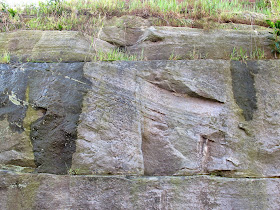 |
| Hawkesbury sandstone, Fairlight Sydney, showing bedding, cross-bedding and vertical joints. |
The sand that would become this sandstone was laid down in a time when plants were ferns, reptiles were becoming dinosaurs, and mammals were only just being thought about. True, there are some remnants of more recent volcanoes around, but almost everything that you can see is good old-fashioned sedimentary rock, lying in almost horizontal layers.
The sandstone has also influenced local architecture, since
it was readily available as a building material, but the beauty of the stone
carries a high price. Many local
buildings of carved sandstone are now beginning to deteriorate as the stone
frets and falls apart, returning to sand again.
I don't think I have once seen the 19th century buildings of the
University of Sydney free of stonemasons' scaffolding in over thirty years, and
the Anglican St Andrew's Cathedral, near Town Hall, is also suffering the ravages
of time.
At the Heads, in the cliffs at the harbour's mouth, there is
sandstone from sea level and below, all the way up to the top of the
cliffs. If you visit North Head, you can
look back along the near coast-line to the north. If you look down, you will see a few lenses
of shale scattered through the cliff face, almost lost among huge layers of
sandstone.
 |
| The heat of the lava 'baked' the sandstone, changing it to quartzite. This is called contact metamorphism. |
North and south, the bottom of the basin starts to curve
up. This curving brings the buried shale
beds up to show at sea level near Narrabeen in the north and at the Royal
National Park to the south. To the west,
the surface of the land rises as the rocks curve up, so right up into the Blue
Mountains, a kilometre in the air, the surface rocks are still Triassic
sandstone of the Narrabeen series that lies under the Hawkesbury sandstone on
the coast. Beneath that again, there are
beds of Permian coal which are nominally about twenty five million years older,
but these lie hidden under a ponderous overburden of sandstone.
These lurking coal beds bob up above sea level when you go
further away, at Wollongong in the south, and Newcastle in the north, and they
break the surface at Lithgow in the west, once you drop down off the mountain
tops. Around 1900, coal was actually mined
in Balmain, a Sydney suburb, thousands of feet below sea level, with the coal
starting at about 3000 feet (900 metres) from sea-level, with the bottom of the
coal lying between there and some 4500 feet (1250 metres).
A cap of younger Wianamatta shale tops off some of the
higher sandstone ridges, giving patches of rich soil. The early development of Sydney was partly
determined by people moving out along these ridges, either for farming, or for
brick-making clay. The roads, the farms,
and the railways all followed the ridges.
But almost the whole of Sydney's vegetation and the
topography of the harbour and the north has been determined by the Hawkesbury
sandstone, and it is there that we must concentrate our attention. The plants of the Sydney region have to
thrive in soil miserably poor in essential minerals, sandy soil that quickly
drains away most of the moisture. As a
result, many of the plants that are native to the area have evolved special
survival tricks. Our plants either live
on the smell of an oily rag, or they use guile and cunning to gather what they
need.
 |
| Sundew, Drosera spatulata. |
Usually, cliffs wear away fastest at the top, forming
gentler and gentler slopes. But when a
cliff of jointed rock is undercut by waves or running water, the rock above the
cut falls down, breaking off along the joint-plane. This keeps the cliff-line vertical, like the
cliffs of Sydney's headlands, and some of the inland cliffs of the Blue
Mountains.
The whole of the Sydney area was once a flat coastal plain
that was lifted up to a height of some hundreds of metres — either that, or the
sea level fell, but the effect was much the same. Small streams on the new plateau ran along
the rectangular joint-lines, and cut down almost to the new sea level, making a
fern-leaf pattern of valleys at right angles to each other. Then the sea rose, drowning the deeper river
valleys and giving us the rich structures of Sydney Harbour, Broken Bay, and
Port Hacking. Botany Bay has a shape
that depends more on the placement of recent sediment, though the Georges
River, which runs into the bay, shows the same basic pattern.
By controlling the road and railway routes, the Hawkesbury
sandstone determined where people would live and build their homes. The deep sandstone valleys were left largely
alone, for roads were too hard to build, and the ground too precipitous for
easy building. Now, when bushfires come
in the summer, they spread through the bush in the valleys and rush up the
hills to sear the houses above.
The sandstone has also had a strong influence on public
works. Steep-sided drowned river valleys
demand bridges for road transport.
Worse, the sandstone is very hard to carve or tunnel through. The chalk of Paris and the London clay, make
underground railways much more feasible in those cities, but only the very
centre of the city sees our trains going beneath the surface. Sydney is a city of bridges, with just the
occasional tunnel, all ruled by the sandstone that lies beneath our feet.
No comments:
Post a Comment